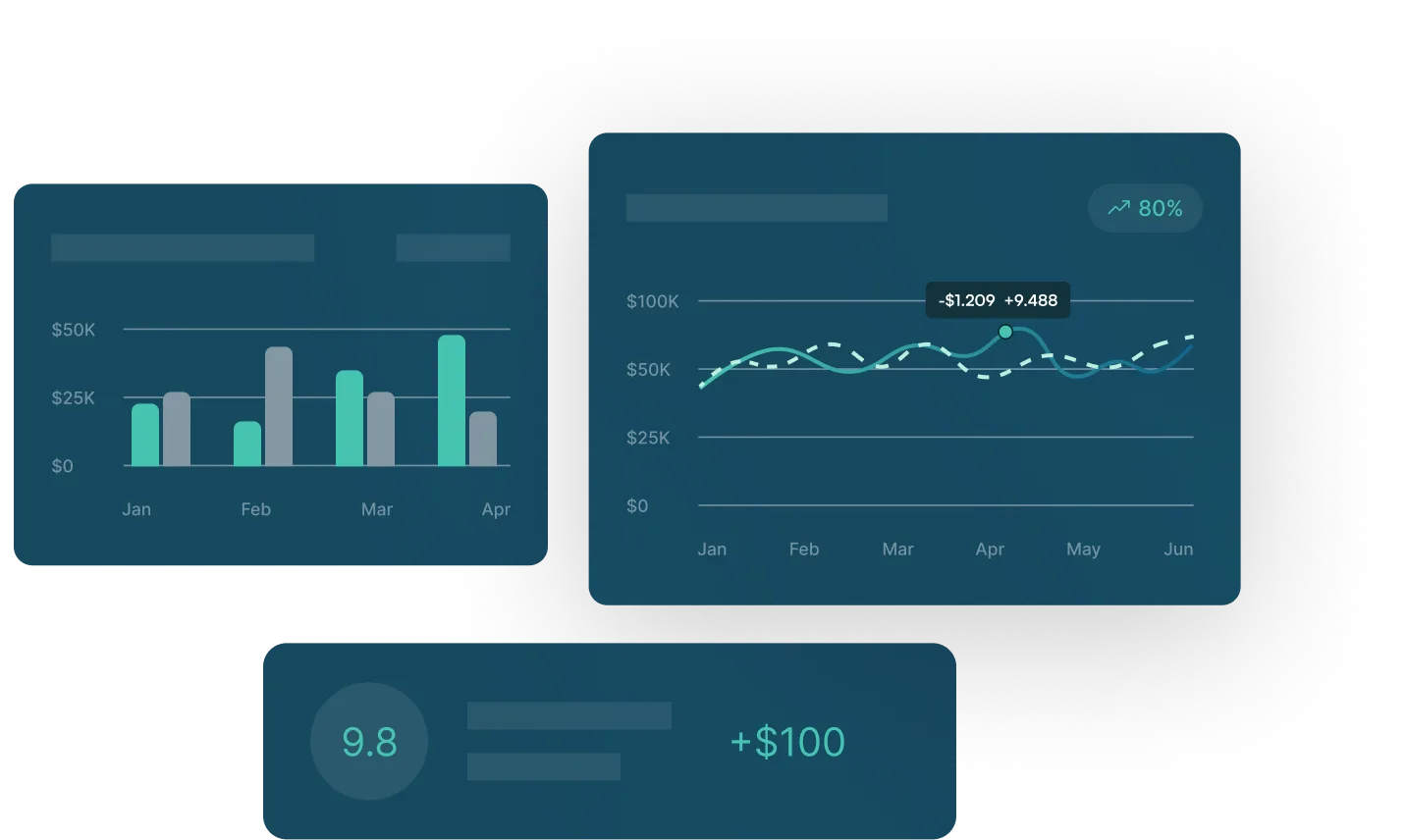How to Use A 13-Week Cash Flow Model


When setting up a new cash forecasting model, time horizons should be chosen intentionally. There are short, medium, and long-range forecasts covering 0 to three months, three months to one year, and several years, respectively.
The period length you pick determines what information you can uncover from your financial model — whether that’s daily payments, weekly cash receipts, or quarterly sales trends. For medium-term cash planning and decision-making, many businesses use 13-week cash flow forecasting.
Uses of a 13-Week Cash Flow Model
13-week forecasts are ideal for gauging a company’s financial health and future cash flows — whether you’re a CFO or an investor.
Corporate senior management, including the CFO, typically uses 13-week models in quarterly planning and strategy sessions. Leadership also uses these models to identify potential liquidity shortfalls, especially if the company is in financial distress.
Outside of the company, investors use 13-week cash forecasts to evaluate the overall health of businesses. These financial statements are also often a requirement for reporting to banks and lenders.
Advantages of a 13-week Cash Flow Forecast
Provides Reliable Insights
The accuracy of a forecast often decreases the further it extends into the future because business environments are constantly changing.
The 13-week forecasting model is just short enough to be reliable because it lets you use historical data to estimate cash flow in the near term. But unlike short-term model (think weekly forecasting), the 13-week framework still provides a long-term view.
Aids Medium-Term Planning Without Affecting Long-Term Planning
With the 13-week cash flow model, there is barely any friction between current and future plans.
Thirteen weeks of visibility allow leaders to make medium-term cash management plans — including debt drawdowns, loan repayments, and investments. But a 13-week forecasting model won’t interrupt long-term plans like setting up new plants and capital expenditure budgeting.
Shows Granular Details
A 13-week cash flow forecasting process typically shows weekly reporting periods, not just the multi-week view. This perspective helps internal and external leaders discuss, analyse, and improve medium-term cash planning while viewing the model.
Enables Medium-Term Liquidity Risk Forecasting
A 13-week cash flow model provides weekly liquidity visibility, so it’s accurate enough for leadership to identify medium-term liquidity risks. Thirteen weeks also offer ample time to take action and resolve those issues.
Say you identify a potential liquidity shortfall with 10 weeks’ notice. The treasury team can spend three weeks arranging bank funding or reviewing intercompany lending options.
Informs Quarterly Planning
Senior management will always want cash balance reports on their own key reporting dates — monthly, quarterly, or yearly. A weekly rolling 13-week cash flow forecast covers a full quarter and provides cash visibility on the next key reporting date or by quarter-end.
Facilitates Bank and Investor Reporting
Banks and investors will only put their money in a company that can show creditworthiness and good financial control. A 13-week cash forecast provides clear visibility of a company’s working capital, so banks and investors can use the model to evaluate businesses.
When is a 13-Week Cash Flow Forecast Not Suitable?
Short-Term Liquidity Planning
If business objectives focus on short-term liquidity planning, a short forecast horizon is better than a 13-week cash flow. For example, a 10- or 15-business-day model is better suited for a company looking to quickly settle debts.
A short-term forecast could have daily or weekly cash flow reporting periods. This granularity lets you report on high-level flows and cash positions with a higher degree of accuracy and at a more precise date in the very near term.
Long-Term Liquidity Risk Management
Medium-term liquidity issues can be identified and actioned with a 13-week forecast horizon. But a six-month forecast horizon (done on a weekly basis for 13 weeks and then monthly for the following three months) will be better at flagging up long-term liquidity risk issues — like whether or not you have enough cash to fuel expansion initiatives.
How to Choose the Right Time Horizon
Select a time horizon that meets forecast objectives and aligns with your business model.
Use a short time horizon if your business needs to manage lines of credit, high interest rates, and heavy liability. This period length will give you day-to-day liquidity visibility, so you can plan your spending accordingly.
If you run a company with steady cash inflows and a high valuation, a short-term model will not be as essential. But generally, this financial model shows the real-time financial health of your company, so you can quickly spot any arising shortfalls.
During a financial crisis like a war or pandemic, you should consider a combination of short- and long-term forecast models. For example, you could combine a 13-week cash flow with a five-year cash flow plan and one-year plan to create a rolling budget and prepare for multiple scenarios — best case, worst case, and expected case.
The different models will reflect varying outcomes based on how far in the future each forecast goes. These figures can then be used for more accurate cash planning.
Whatever time frame or combination you pick, use specialised cash flow forecasting software for your company's cash and liquidity forecasts. The software will:
- Improve forecast accuracy and quality.
- Reduce the administrative burden of forecasts.
- Allow time for analysis.
With CashAnalytics, for instance, you can set up a rolling 13-week cash flow model and look at your weekly forecasts at the touch of a button. You'll be able to quickly conduct variance analysis between forecast figures and actual cash, identify biases, and make corrections as necessary.
How to Set Up a 13-Week Cash Flow Model on Your Own
To create your own 13-week forecasting process, we’ve put together a 13-week cash flow forecast setup guide. The guide takes an in-depth look at how companies can build their own 13-week cash flow forecast model and practical tips. Here’s a quick walkthrough of its main points to help you set up your own system manually (on Excel, for example):
Map Out Stakeholders’ Requirements
Identify and understand the needs of all stakeholders in your forecasting process — the people who will use the model. These people may include:
- The CFO
- The CEO
- Board members
- Shareholders
- Investors
- Private equity general partners
For example, your firm’s stakeholders may be looking to improve forecast accuracy, simplify intercompany financial data collection, gain operating cash flow (OCF) visibility, or build reports more quickly.
Determine what stakeholders want from the 13-week model, so you’re ready to build a helpful forecast.
Identify Data Sources
There is a wide range of data sources that feed into your 13-week forecast. These sources could include:
- Bank accounts
- Enterprise resource planning (ERP) systems
- Accounts receivable (AR) and accounts payable (AP) ledgers
- Annual budgets
- Financial planning and analysis (FP&A) tools
- Booking systems
- CRM tools
- Treasury management systems (TMS)
- E-commerce back-end systems
Note your data sources, so you know which tools you'll need to connect to your 13-week model. Say you connect all your bank accounts in an ERP system from which you create accurate AR and AP ledgers. This connectivity is especially important for a 13-week forecast because you have to create the forecast on a weekly rolling basis.
People in different units across the business will also be significant forecast data contributors. People usually add finishing touches to the forecast, and this input has the ability to move forecast accuracy from circa 60% to above 90%.
Manually collecting forecast data from multiple business unit controllers adds an extra layer of complexity to your cash flow model. The head office treasurer or financial controller will need to consolidate all of this data into a company-wide cash forecast.
Design the 13-Week Model
Your 13-week forecasting model is made up of two parts in a spreadsheet: model dimensions and input data. Model dimensions present output data made up of reporting periods and reporting categories. Meanwhile, input data includes actual and forecast figures.

As shown in the example above, reporting categories include receipts (cash inflows) and payments (cash outflows). And for a 13-week cash flow model that has a weekly forecast frequency, the reporting period is weekly for 13 weeks.
Generally, each scenario requires different headline classifications and granularity. So you should break down reporting categories into headline rows and line items based on the requirements you mapped out earlier.
Other headline classifications you can explore are capital expenditure, tax, intercompany cash movements, and debt/interest payments.
Put the Process in Place
A cash forecast is just as good as the process that underpins it — getting buy-in for the model, documenting and communicating requirements, and assigning responsibility.
Encourage users to adopt the new cash flow model by getting executive sponsorship first. If the CFO supports the process, business unit controllers are likely to implement it with little resistance.
Document the requirements you mapped out earlier, so you’ll use them as a measure of success for the model. Then communicate these goals to every project contributor so that they’ll be aware of the model’s value and become more enthusiastic about getting involved.
Collect data in a timely manner and minimise forecast errors by defining who handles what data and deadlines for feeding that data into your system.
In many cases, one key player — like the CFO or head treasurer — will be in charge of setting these responsibilities and driving the forecast process. This executive will also be responsible for ensuring data quality and accuracy, as well as improving the process as the need arises.
How to Automate Your 13-Week Cash Flow Model
While you can manually create your 13-week model, you’ll save time and minimise errors by automating the forecasting process.
Here at GTreasury, we have helped different companies switch from spreadsheets to automated forecasting with our cash flow software. We connect our tool with their data sources to track and consolidate intercompany cash flows while building out custom dashboards that meet their forecast requirements. Our range of data visualization features also aid financial reporting and analysis at the touch of a button.
Building Out a New Cash Forecasting Process?
Are you considering setting up a new cash forecasting process? We have written a cash flow forecasting setup guide and a data-driven cash forecasting guide. Both discuss the practicalities of designing a forecasting model for a variety of time horizons. This resource also outlines what you need to prepare for rolling out a new forecasting system to business units and what comes after its launch.
With a dedicated cash forecasting and liquidity reporting software like GTreasury, you will better understand your company’s current and future liquidity positions. Want to see a live demonstration of our tool and find out how to create your own dashboard in six weeks? Contact us directly any time.
How to Use A 13-Week Cash Flow Model
When setting up a new cash forecasting model, time horizons should be chosen intentionally. There are short, medium, and long-range forecasts covering 0 to three months, three months to one year, and several years, respectively.
The period length you pick determines what information you can uncover from your financial model — whether that’s daily payments, weekly cash receipts, or quarterly sales trends. For medium-term cash planning and decision-making, many businesses use 13-week cash flow forecasting.
Uses of a 13-Week Cash Flow Model
13-week forecasts are ideal for gauging a company’s financial health and future cash flows — whether you’re a CFO or an investor.
Corporate senior management, including the CFO, typically uses 13-week models in quarterly planning and strategy sessions. Leadership also uses these models to identify potential liquidity shortfalls, especially if the company is in financial distress.
Outside of the company, investors use 13-week cash forecasts to evaluate the overall health of businesses. These financial statements are also often a requirement for reporting to banks and lenders.
Advantages of a 13-week Cash Flow Forecast
Provides Reliable Insights
The accuracy of a forecast often decreases the further it extends into the future because business environments are constantly changing.
The 13-week forecasting model is just short enough to be reliable because it lets you use historical data to estimate cash flow in the near term. But unlike short-term model (think weekly forecasting), the 13-week framework still provides a long-term view.
Aids Medium-Term Planning Without Affecting Long-Term Planning
With the 13-week cash flow model, there is barely any friction between current and future plans.
Thirteen weeks of visibility allow leaders to make medium-term cash management plans — including debt drawdowns, loan repayments, and investments. But a 13-week forecasting model won’t interrupt long-term plans like setting up new plants and capital expenditure budgeting.
Shows Granular Details
A 13-week cash flow forecasting process typically shows weekly reporting periods, not just the multi-week view. This perspective helps internal and external leaders discuss, analyse, and improve medium-term cash planning while viewing the model.
Enables Medium-Term Liquidity Risk Forecasting
A 13-week cash flow model provides weekly liquidity visibility, so it’s accurate enough for leadership to identify medium-term liquidity risks. Thirteen weeks also offer ample time to take action and resolve those issues.
Say you identify a potential liquidity shortfall with 10 weeks’ notice. The treasury team can spend three weeks arranging bank funding or reviewing intercompany lending options.
Informs Quarterly Planning
Senior management will always want cash balance reports on their own key reporting dates — monthly, quarterly, or yearly. A weekly rolling 13-week cash flow forecast covers a full quarter and provides cash visibility on the next key reporting date or by quarter-end.
Facilitates Bank and Investor Reporting
Banks and investors will only put their money in a company that can show creditworthiness and good financial control. A 13-week cash forecast provides clear visibility of a company’s working capital, so banks and investors can use the model to evaluate businesses.
When is a 13-Week Cash Flow Forecast Not Suitable?
Short-Term Liquidity Planning
If business objectives focus on short-term liquidity planning, a short forecast horizon is better than a 13-week cash flow. For example, a 10- or 15-business-day model is better suited for a company looking to quickly settle debts.
A short-term forecast could have daily or weekly cash flow reporting periods. This granularity lets you report on high-level flows and cash positions with a higher degree of accuracy and at a more precise date in the very near term.
Long-Term Liquidity Risk Management
Medium-term liquidity issues can be identified and actioned with a 13-week forecast horizon. But a six-month forecast horizon (done on a weekly basis for 13 weeks and then monthly for the following three months) will be better at flagging up long-term liquidity risk issues — like whether or not you have enough cash to fuel expansion initiatives.
How to Choose the Right Time Horizon
Select a time horizon that meets forecast objectives and aligns with your business model.
Use a short time horizon if your business needs to manage lines of credit, high interest rates, and heavy liability. This period length will give you day-to-day liquidity visibility, so you can plan your spending accordingly.
If you run a company with steady cash inflows and a high valuation, a short-term model will not be as essential. But generally, this financial model shows the real-time financial health of your company, so you can quickly spot any arising shortfalls.
During a financial crisis like a war or pandemic, you should consider a combination of short- and long-term forecast models. For example, you could combine a 13-week cash flow with a five-year cash flow plan and one-year plan to create a rolling budget and prepare for multiple scenarios — best case, worst case, and expected case.
The different models will reflect varying outcomes based on how far in the future each forecast goes. These figures can then be used for more accurate cash planning.
Whatever time frame or combination you pick, use specialised cash flow forecasting software for your company's cash and liquidity forecasts. The software will:
- Improve forecast accuracy and quality.
- Reduce the administrative burden of forecasts.
- Allow time for analysis.
With CashAnalytics, for instance, you can set up a rolling 13-week cash flow model and look at your weekly forecasts at the touch of a button. You'll be able to quickly conduct variance analysis between forecast figures and actual cash, identify biases, and make corrections as necessary.
How to Set Up a 13-Week Cash Flow Model on Your Own
To create your own 13-week forecasting process, we’ve put together a 13-week cash flow forecast setup guide. The guide takes an in-depth look at how companies can build their own 13-week cash flow forecast model and practical tips. Here’s a quick walkthrough of its main points to help you set up your own system manually (on Excel, for example):
Map Out Stakeholders’ Requirements
Identify and understand the needs of all stakeholders in your forecasting process — the people who will use the model. These people may include:
- The CFO
- The CEO
- Board members
- Shareholders
- Investors
- Private equity general partners
For example, your firm’s stakeholders may be looking to improve forecast accuracy, simplify intercompany financial data collection, gain operating cash flow (OCF) visibility, or build reports more quickly.
Determine what stakeholders want from the 13-week model, so you’re ready to build a helpful forecast.
Identify Data Sources
There is a wide range of data sources that feed into your 13-week forecast. These sources could include:
- Bank accounts
- Enterprise resource planning (ERP) systems
- Accounts receivable (AR) and accounts payable (AP) ledgers
- Annual budgets
- Financial planning and analysis (FP&A) tools
- Booking systems
- CRM tools
- Treasury management systems (TMS)
- E-commerce back-end systems
Note your data sources, so you know which tools you'll need to connect to your 13-week model. Say you connect all your bank accounts in an ERP system from which you create accurate AR and AP ledgers. This connectivity is especially important for a 13-week forecast because you have to create the forecast on a weekly rolling basis.
People in different units across the business will also be significant forecast data contributors. People usually add finishing touches to the forecast, and this input has the ability to move forecast accuracy from circa 60% to above 90%.
Manually collecting forecast data from multiple business unit controllers adds an extra layer of complexity to your cash flow model. The head office treasurer or financial controller will need to consolidate all of this data into a company-wide cash forecast.
Design the 13-Week Model
Your 13-week forecasting model is made up of two parts in a spreadsheet: model dimensions and input data. Model dimensions present output data made up of reporting periods and reporting categories. Meanwhile, input data includes actual and forecast figures.

As shown in the example above, reporting categories include receipts (cash inflows) and payments (cash outflows). And for a 13-week cash flow model that has a weekly forecast frequency, the reporting period is weekly for 13 weeks.
Generally, each scenario requires different headline classifications and granularity. So you should break down reporting categories into headline rows and line items based on the requirements you mapped out earlier.
Other headline classifications you can explore are capital expenditure, tax, intercompany cash movements, and debt/interest payments.
Put the Process in Place
A cash forecast is just as good as the process that underpins it — getting buy-in for the model, documenting and communicating requirements, and assigning responsibility.
Encourage users to adopt the new cash flow model by getting executive sponsorship first. If the CFO supports the process, business unit controllers are likely to implement it with little resistance.
Document the requirements you mapped out earlier, so you’ll use them as a measure of success for the model. Then communicate these goals to every project contributor so that they’ll be aware of the model’s value and become more enthusiastic about getting involved.
Collect data in a timely manner and minimise forecast errors by defining who handles what data and deadlines for feeding that data into your system.
In many cases, one key player — like the CFO or head treasurer — will be in charge of setting these responsibilities and driving the forecast process. This executive will also be responsible for ensuring data quality and accuracy, as well as improving the process as the need arises.
How to Automate Your 13-Week Cash Flow Model
While you can manually create your 13-week model, you’ll save time and minimise errors by automating the forecasting process.
Here at GTreasury, we have helped different companies switch from spreadsheets to automated forecasting with our cash flow software. We connect our tool with their data sources to track and consolidate intercompany cash flows while building out custom dashboards that meet their forecast requirements. Our range of data visualization features also aid financial reporting and analysis at the touch of a button.
Building Out a New Cash Forecasting Process?
Are you considering setting up a new cash forecasting process? We have written a cash flow forecasting setup guide and a data-driven cash forecasting guide. Both discuss the practicalities of designing a forecasting model for a variety of time horizons. This resource also outlines what you need to prepare for rolling out a new forecasting system to business units and what comes after its launch.
With a dedicated cash forecasting and liquidity reporting software like GTreasury, you will better understand your company’s current and future liquidity positions. Want to see a live demonstration of our tool and find out how to create your own dashboard in six weeks? Contact us directly any time.

See GTreasury in Action
Get connected with supportive experts, comprehensive solutions, and untapped possibility today.































.jpg)
.png)


























.png)




.jpeg)

.jpeg)











.jpeg)


.jpeg)







.jpeg)


.jpeg)









.jpeg)















.jpg)




